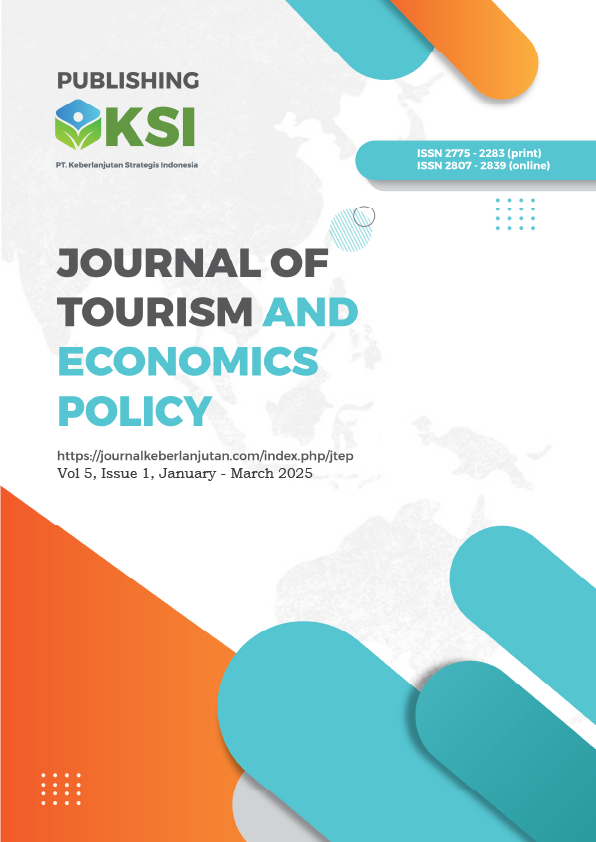Balinese Public Perception Towards Climate Change Adaptation (Case Study: Governor's Regulation No. 48 Of 2019 On the Use of Battery-Based Electric Motor Vehicles)
DOI:
https://doi.org/10.38142/jtep.v5i2.1308Keywords:
Climate Change, Consumer Behavior, Citizen PerceptionAbstract
The Bali Provincial Government has welcomed the Indonesian government's commitment to contribute to reducing greenhouse gas emissions. This study was conducted to determine the perception of the Balinese people towards the climate change adaptation policy that the Bali Provincial Government has made. The study was conducted qualitatively using content analysis. Interviews were conducted with respondents in the Sanur Tourism Area until the saturation point was reached. The results obtained were that most of the climate change perception stimuli were obtained through the sense of taste. There are three groups of perceptions, namely negative, positive, and neutral towards the policy of Governor Regulation No. 48 of 2019. In addition, some people feel the benefits and disadvantages personally and in the community. Based on the results of this study, it can be seen that the tendency of the formation of respondents' perceptions is based on the work environment and daily activities. However, this policy is considered impossible for most people who do not have a choice of transportation modes. It is hoped that this study can provide information to local governments.
References
Adger, W. N., Quinn, T., Lorenzoni, I., & Murphy, C. (2018). The Social Contract for Climate Risks. Institutional Capacity for Climate Change Response, 76, 76-89. https://doi.org/10.9774/gleaf.9781315651354_7
Dewi, K. G. P., Kurniawan, K. A., & Putra, I. W. G. Y. D. (2024). Environmental Innovation and Sustainability Practices Manufacturing Companies in Bali Through Government Regulations. Journal of Tourism Economics and Policy, 4(4), 430-443. https://doi.org/10.38142/jtep.v4i4.1166
Erlingsson, C., & Brysiewicz, P. (2017). A Hands-On Guide to Doing Content Analysis. African journal of emergency medicine, 7(3), 93-99. https://doi.org/10.1016/j.afjem.2017.08.001
Ghali-Zinoubi, Z. (2022). Examining Drivers of Environmentally Conscious Consumer Behavior: Theory of Planned Behavior Extended with Cultural Factors. Sustainability, 14(13), 8072. https://doi.org/10.3390/su14138072
Hsieh, H.-F., & Shannon, S. E. (2005). Three Approaches to Qualitative Content Analysis. Qualitative Health Research, 15(9), 1277–1288. https://doi.org/10.1177/1049732305276687
Indonesia, C. (2023, January 4). Pakar Ungkap Hubungan Cuaca Ekstrem dan Pemanasan Global. Teknologi. https://www.cnnindonesia.com/teknologi/20230104090031-199-895870/pakar-ungkap-hubungan-cuaca-ekstrem-dan-pemanasan-global
Indonesia's updated NDC for a climate-resilient future. Indonesia's Updated NDC for a Climate Resilient Future | NDC Partnership. (2021, October 12). https://ndcpartnership.org/news/indonesias-updated-ndc-climate-resilient-future
James, O., & Moseley, A. (2014). Does Performance Information About Public Services Affect Citizens'perceptions, Satisfaction, and Voice Behaviour? Field Experiments with Absolute and Relative Performance Information. Public administration, 92(2), 493-511. https://doi.org/10.1111/padm.12066
Julaeha, S. (2023). Group Solidarity Based on Halal Network Labels: Moral Embeddedness of Agents of PT. HNI HPAI from an Economic Sociology Perspective. International Journal of Social Science and Business, 7(2), 253–260. https://doi.org/10.23887/ijssb.v7i2.54938
Kondracki, N. L., Wellman, N. S., & Amundson, D. R. (2002). Content Analysis: Review of Methods and Their Applications in Nutrition Education. Journal of nutrition education and behavior, 34(4), 224-230. https://doi.org/10.1016/S1499-4046(06)60097-3
Mayring, P. (2000, February). Combination and Integration of Qualitative and Quantitative Analysis. in Forum Qualitative Sozialforschung/Forum: Qualitative Social Research (Vol. 2, No. 1).
Nurhaliza, S. (2022, July 27). Gubernur: Bali komitmen dorong Penggunaan Kendaraan Listrik. Antara News. https://otomotif.antaranews.com/berita/3021913/gubernur-bali-komitmen-dorong-penggunaan-kendaraan-listrik
Solomon, M. R. (2022). Consumer Behaviour: Buying, having, being. Pearson.
Sukartini, N. M., & Solihin, A. (2013). Respon Petani Terhadap Perkembangan Teknologi dan Perubahan Iklim: Studi Kasus Subak di Desa Gadungan, Tabanan, Bali. Jurnal Ekonomi Kuantitatif Terapan, 6(2), 128-139.
Tesch, R. (1990). Qualitative research: Analysis types & tools. Routledge.
Thøgersen, J. (2021). Consumer Behavior and Climate Change: Consumers Need Considerable Assistance. Current Opinion in Behavioral Sciences, 42, 9-14. https://doi.org/10.1016/j.cobeha.2021.02.008
Van de Walle, S., & Bouckaert, G. (2007). Perceptions of Productivity and Performance in Europe and the United States. International Journal of Public Administration, 30(11), 1123-1140. https://doi.org/10.1080/01900690701225309
Wit. (2020). Program Pertumbuhan Ekonomi Hijau (Green Growth Program) Mendukung Indonesia Dalam Mewujudkan Pertumbuhan Ekonomi Hijau Yang dapat Mengurangi Kemiskinan serta memastikan Inklusi Sosial, Kelestarian Lingkungan Dan efisiensi Sumber Daya. Green Growth. http://greengrowth.bappenas.go.id/en/indonesias-updated-ndc-for-a-climate-resilient-future/
Downloads
Published
Issue
Section
License
Copyright (c) 2025 Sukmasari Triana Gita PUTRI

This work is licensed under a Creative Commons Attribution-NonCommercial 4.0 International License.
Creative Commons Attribution-NonCommercial 4.0 International License.





















